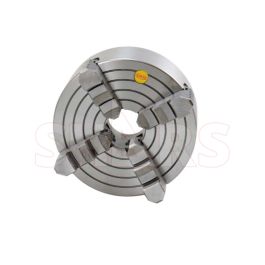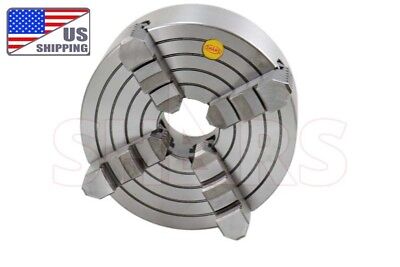-
Welcome back Guest! Did you know you can mentor other members here at H-M? If not, please check out our Relaunch of Hobby Machinist Mentoring Program!
You are using an out of date browser. It may not display this or other websites correctly.
You should upgrade or use an alternative browser.
You should upgrade or use an alternative browser.
Replacing a Lathe Chuck
- Thread starter David2011
- Start date
Ahhh, I see. How cool is thatImagine a 3-jaw chuck that has an internal 4-jaw chuck in the back that latches on to the adapter plate. You loosely bolt the chuck body to the adapter plate with the mounting bolts just barely snug. Then you put something like a ground rod in the 3-jaw chuck jaws, put an indicator on that and adjust the four set screws on the back of the 3-jaw body to zero the runout of the whole assembly. When you've got it zeroed, tighten the bolts mounting the chuck to the adapter plate.
It's not perfect as the zero is really only for the diameter ground rod you just used, but it tends to be very close at other diameters as well...like a couple of thousandths. If needed, you can zero the chuck to a different diameter. I tend to zero mine for something around 1" as that's a good middle ground for most of my work.
This is an 8" Buck True Adjust chuck with a matching Buck adapter plate next to it...you can see how they fit together. The critical thing is that there's a gap between the inside recess of the chuck and the hub on the adapter plate and that the nose of the hub doesn't touch the back of the chuck...you want the chuck essentially floating on the face of the adapter only.
View attachment 486465
- Joined
- Dec 9, 2021
- Messages
- 735
I didn't explain it clearly. I was talking about the difference in depth of the counterbore in the back of the chuck vs. the length of the protrusion of the back plate that the adjusting screws bear against, not the difference in diameter of the counterbore and the diameter of the protrusion. My point is that it is better to have a gap than to risk the chuck hitting the protrusion before the mounting face of the chuck meets the back plate.This seems to be a topic of great debate, in both directions. Several manufacturers specify a total of .008" which really only gives .004" in any direction, and seems quite lot to me. Others have a range .007 to .012" which is more reasonable. Others call for .020" and if you listen to some of the CNC folks they run upwards of 1/8" clearance. The last couple I've done I went with around .020" and it's been fine.
The one thing people need to check is that the clearance doesn't exceed the available travel of the adjusting screws. The adjusting screws and the boss on the adapter plate aren't really doing anything once the chuck is secured to the backing plate, so the clearance between the chuck and the boss shouldn't really matter.
Edit to add: I just came in from the shop and curiosity got to me. I have an 8" Buck True Adjust and matching Buck adapter plate (pictured below) that isn't being used so I measured the ID/OD on them. The OD of the hub is exactly .030" smaller than the ID of the chuck recess. I have no idea if it came that way from Buck or not, but thought it was worth checking.
You did a great job of discussing the range of adjustment in the later post. I've never run out of adjustment with my Buck 6" 3- and 6- jaws, nor have I had any noticeable vibration. I assume that the offset has been too small to show up as vibration.
This week the CME adjustable structure 6” 3 jaw chuck and a suitable 8” D1-4 back plate arrived. The back plate has plenty of metal to cut down to fit the chuck and it’s thick enough without adding a spacer. I got back onto degreasing the lathe in preparation for paint. The degreasing was almost finished when other things diverted my attention for the last two weeks so there’s not much left. The outer sides and fronts of the base and the front of the sheet metal between the base pedestals are all that’s left. Saturday one of the RC clubs to which I belong is having an event so I probably won’t get back to degreasing and painting until Sunday.
Hoping that painting will go fairly quickly and I can move the lathe into its place on Sunday or Monday. I’ll sand all surfaces that haven’t already been sanded with a palm sander and wipe down everything with mineral spirits before applying paint.
At this point there are 3 back plates to machine; one each for the 5C, ER40 and 6” 3 jaw chucks. I didn’t want to start making chips on a very clean lathe until the paint was on and cured.
Hoping that painting will go fairly quickly and I can move the lathe into its place on Sunday or Monday. I’ll sand all surfaces that haven’t already been sanded with a palm sander and wipe down everything with mineral spirits before applying paint.
At this point there are 3 back plates to machine; one each for the 5C, ER40 and 6” 3 jaw chucks. I didn’t want to start making chips on a very clean lathe until the paint was on and cured.
Starting to think about getting an 8" 4 jaw chuck. My shoulders aren't as good as they used to be so weight is a concern. Is there any disadvantage to using a direct mount chuck compared to a plain back with a back plate?
The above mentioned 6" 3 jaw and back plate is close to 40 pounds. That's about my upper comfort limit for handling things at chest height. Beyond that I would consider a small shop built crane mounted to the lathe. A Shars 8" 4 jaw direct D1-4 weighs about 31 pounds. The plain back chuck with a back plate is about 48 pounds; quite a bit heavier and I'm only getting older.
The above mentioned 6" 3 jaw and back plate is close to 40 pounds. That's about my upper comfort limit for handling things at chest height. Beyond that I would consider a small shop built crane mounted to the lathe. A Shars 8" 4 jaw direct D1-4 weighs about 31 pounds. The plain back chuck with a back plate is about 48 pounds; quite a bit heavier and I'm only getting older.
- Joined
- Dec 24, 2020
- Messages
- 1,038
I don't think you give up much, if anything, when you're talking about a 4J independent chuck that's direct mount. After all, you're going to zero it out with an indicator each time, so any little error from the mounting setup will get adjusted away.Starting to think about getting an 8" 4 jaw chuck. My shoulders aren't as good as they used to be so weight is a concern. Is there any disadvantage to using a direct mount chuck compared to a plain back with a back plate?
The above mentioned 6" 3 jaw and back plate is close to 40 pounds. That's about my upper comfort limit for handling things at chest height. Beyond that I would consider a small shop built crane mounted to the lathe. A Shars 8" 4 jaw direct D1-4 weighs about 31 pounds. The plain back chuck with a back plate is about 48 pounds; quite a bit heavier and I'm only getting older.
The only thing I'd suggest would be to mention that more often than not, buying from Shars directly usually costs more than buying from them via eBay. It looks like it's about $20 cheaper going through eBay.

8" D1-4 4 Jaw Independent Lathe Chuck

Shars 8" 4 Jaw Independent Lathe Chuck D1-4 TIR Runout Certificate R[ | eBay
Both side of jaw teeth and guides are ground and hardened to HRC 58-62. 7/16" Self-Ejecting Lathe Chuck Key. Internal Jaw Chuck Thickness 2.963. Semi-steel chuck body made from high quality cast iron.
www.ebay.com
Right. I've been shopping for a while. The Shars eBay outlet is usually but not always the best price for Shars items. Going through Shars direct is about $246 compared to $223 through their Discount Machine Shop eBay outlet. The worst price is through Amazon. The price is the same as eBay but Amazon shipping is over $70.

